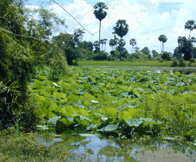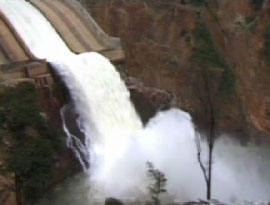Changes to fish communities
Some of the effects on river ecology described above have direct effects
on fishes, as mentioned, but - because of their importance to human welfare
- their impacts deserve special attention.
Changes to the Aquatic Communities
Substantial changes occur to biota below a dam. The most direct of these
is the blocking of the pathway by which invertebrates and fish travel
upstream and downstream. This may result in the complete elimination of
species dependent of migrations upstream for breeding, or at least a drastic
change in their abundance. It can also mean the genetic segregation of
different blocks of the same species and the failure to recolonise a reach
of river that is overfished. These effects are not the only ones and fundamental
changes occur to plants and animals both upstream and downstream of dams.
Upstream Effects
Effects upstream of the dam are felt in the channel of the river and in
the new waterbody that is formed.
Effects in River Channels. The bar to migration is felt upstream, because
riverine invertebrate and vertebrate species that would have come from
downstream to upstream habitats are no longer able to pass the dam. Localised
populations of migratory species may be retained if the tributary rivers
above the reservoir are of significant size and are not disturbed. In
these cases, the retention of species that are able to continue to live
in the river and upstream tributaries of the reservoir depends on the
preservation of a suitable upstream environment for breeding and feeding
by the organisms affected. Building further reservoirs upstream destroy
any longitudinal migration, and the animal populations that previously
depended on the migratory pathway will be at risk.
The slower water in reservoirs means that invertebrates, and fish eggs
and larvae that are normally transported by the current in rivers in the
drift, settle to the bottom and are killed. Therefore reservoirs and dams
pose a barrier to downstream migration of many invertebrates and young
fish.
The Reservoir. Reservoirs can be divided into two effective zones, each
of which has a characteristic fauna. Upstream, in the deposition area,
there is a riverine zone where many of the original riverine invertebrate
and fish species persist. Excessive silting in this zone may affect the
bottom living invertebrates that rely on clean, sediment-free conditions
in the main river. In the body of the reservoir there is a lacustrine
(= 'lake-like') zone where true lacustrine phyto- and zooplankton develop.
Floating vegetation such as the water fern (and the water hyacinth) may
form extensive mats covering large areas of the reservoir. Lacustrine
insects also colonize the reservoir and organisms such as lake flies (chironomids
and chaoborids) can cause a potential nuisance.
Furthermore many disease vectors, particularly the snail hosts of bilharzias and the mosquitoes that carry malaria, thrive in the new environment. Fish faunas become modified to favor lake dwelling species, some of which may be introduced by humans. The open waters of this area are particularly likely to become colonised with small pelagic fish species. The most lacustrine area of all is that closest to the dam where the waters are deepest.
The following changes to the fish fauna can be anticipated after the filling of a reservoir:
• The disappearance of most migratory species from the body of the dam. Some of these may persist in the upper riverine parts of the reservoir;
• The rise in abundance of species that spawn in lacustrine situations;
• The rise in abundance of introduced species such as tilapias that are better adapted to lacustrine conditions;
• The rise in abundance of small pelagic species that are normally rare in the river;
• The dramatic rise in fish catch and later stabilization at a reasonable level of yield.
 Whether
the catch from the reservoir willcompensate for the loss of fisheries
downstream of the reservoir depends on local geographical circumstances.
Whether
the catch from the reservoir willcompensate for the loss of fisheries
downstream of the reservoir depends on local geographical circumstances.
Reservoirs may support valuable fisheries based on the
fish populations that develop in them. In many reservoirs, the fisheries
provide more value than the primary purpose for which the dam was built.
Reservoirs also provide a valued recreation resource with possibilities
for sport fishing, bathing and boating. For this reason, reservoirs should
be carefully managed to give the maximum benefit to human populations.
The fish populations in particular should be carefully conserved by proper
management, avoidance of excessive fishing and by stocking to give the
maximum yield for food and recreational fisheries.
Downstream Effects
Other effects of dams on fishes are felt downstream, as highlighted below.
Short Distance Effects. The water discharged from dams is usually
poor in nutrients, and the carbon flows of a natural river channel are
interrupted (see Section 7, the Serial Discontinuity Concept). Much of
the invertebrate life depends on these food sources and tends to be diminished.
Migrating fish that would normally have migrated upriver past the dam
site tend to accumulate in the tailwater areas below dams. Here they are
especially vulnerable to discharges of deoxygenated and cold water from
the spillways. The accumulations of fish are also vulnerable to predators
including other fish, birds and human fishers.
Long Distance Effects. The major downstream effect is the failure
of normal floods for considerable distances below the dam. This means
that the floodplains that were essential to many of the fish species are
now detached from the river, and seasonal waterbodies and marsh environments
dry out. As a result, the vegetation structure of the natural floodplain
and its former waterbodies changes from water-tolerant species to more
arid varieties. Similarly, many of the invertebrates that are characteristic
of seasonally flooded environments may disappear. Species of fish that
are adapted to floodplain habitats are eliminated or decline in abundance,
and are replaced by other species. New species colonizing the habitat
are often less desirable for food and commerce. In particular, the altered
conditions favour introduced species, which may increase in abundance
and eventually dominate the fishery. Foodplains are the preferred environments
of many species of waterbirds and populations of these may also decline.
In summary, the following changes can be anticipated downstream after
the creation of a major dam:
| • Alteration in the nature and abundance of floodplain vegetation including many varieties of flood resistant trees and grasses; | |||||
| • Diminution of overall productivity as the plankton communities that drive much of the carbon flow in downstream sectors of the river disappear along with the floodplain waterbodies; | |||||
| • Disruption to invertebrate communities; | |||||
| • Disruption to the fish communities with the following changes: | |||||
| o The decline and possible disappearance of migratory (e.g., whitefish) species; | |||||
| o The decline of many of the species that live on the floodplains (e.g., blackfish); | |||||
| o The rise in abundance of unspecialized intermediate species that are able to live in the modified river channel and can tolerate stable flows; | |||||
| o The rise in abundance of introduced and 'nuisance' species; | |||||
| o The decrease in the mean size of fish caught; | |||||
| o The decrease in total abundance of the fish stock; and | |||||
| o The decline of the fishery to lower levels of yield and quality of fish caught. | |||||
| • Reductions to the original waterfowl
population of the former floodplain. |
|||||
|
|
